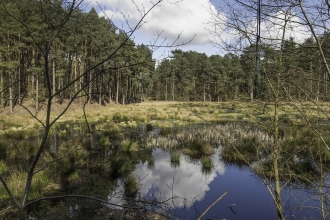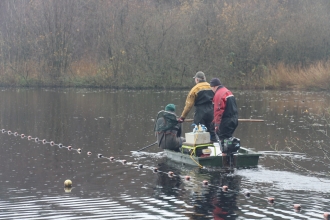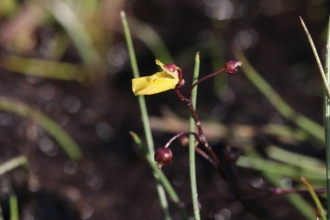Black darter c. Joe Taylor
Delamere - mosses and heathland
We're working with partner agencies, landowners and local communities to create a network of habitats across Delamere that people enjoy and value.
This landscape was first celebrated as of ‘outstanding national value’ in 1947. But since that declaration the quality of many of the habitats has degraded, limiting its value to both people and wildlife.
Spaghnum with cranberry c. Claire Huxley
Over recent years we have been working to improve its habitats for wildlife through joining up the internationally important mossland. This has created ‘stepping stones’ of viable space to help species like butterflies, dragonflies, and reptiles.
In particular, the rare white-faced darter dragonfly, which became extinct in the region over ten years ago, is now benefiting from widespread mossland restoration work and being reintroduced back into Delamere.
These mosslands also host some very specialised plants such as sundew, bilberry, cranberry, bog rosemary and royal fern. It’s not only wildlife that is benefiting; mosslands are a “carbon sink” and can store masses of carbon, helping to limit the effects of climate change.
Through our work, mossland sites have been re-wetted and restored and heathland has been created between sites.
Our most recent project won a CIEEM (Chartered Institute of Ecology and Environmental Management) Best Practice Award.
Bringing back the white-faced darter
White-faced darter c. Kevin Reynolds
Why reintroduce the white-faced darter?
Records of white-faced darters in the Delamere area date back as far as 1882. Adults were present at many, widespread sites and breeding was recorded until relatively recently, but no sightings have been made since.
In 2003, a project led by Colin Hayes of Ecology-First entitled “The Lost Meres and Mosses of Delamere” recognised and identified restorable basin mires. Since then, there has been widespread restoration work across Delamere by the Forestry Commission and Cheshire Wildlife Trust including removal of trees and scrub and the blocking of basin outfalls which has increased the potential habitat suitable for the white-faced darter. The white-faced darter is the emblem for Delamere Forest and is a flagship species for the extensive meres and mosses restoration work taking place across the forest.
A feasibility study in 2011 confirmed there was suitable habitat into which the white-faced darter could be reintroduced.
How do you reintroduce the white-faced darter?
Before the flight season in May, larvae (immature dragonflies in their aquatic stage before they emerge and develop wings) are translocated from the donor sites at Chartley Moss and Fenns & Whixall Mosses NNRs (Stafforshire and Shropshire) to the receptor site in Delamere Forest. White-faced darter larvae are easily distinguised from other species which helps to avoid confusion. Only larger larvae that are in the final stages of the life cylcle and likely to emerge that year are selected.
The second stage of the reintroduction process is the transfer of white-faced darter dragonfly eggs and immature larvae later in the season. The reintroduction needs to take place over several years due to the life cycle of the dragonfly and the number of years its spends as a larvae in the pools.’
Has this been done before?
This is the second ever dragonfly reintroduction in the UK. The first was a similar and successful project in Cumbria also reintroducing the white-faced darter.
How will you know if the project has been successful?
There is extensive monitoring of both donor sites and the receptor sites.
At the donor sites, weekly exuvia (empty larval case) counts take place throughout the white-faced darter flight season. This involves seaching in the vegetation up to five metres from the edge of the white-faced darter pools for the exuvia. When an exuvia is found, it is collected and a number of factors it is recorded.
Weekly exuvia counts also take place at the receptor site, as well as adult dragonfly surveys across Delamere following specific transects (line surveys) using the standard British Dragonfly Society (BDS) methodology.
General observations are made around the reintroduction site for various aspects of adult white-faced darter behaviour such as hunting, roosting, mating, ovipositing and interactions with other species to ensure the ‘fit’ of the species into the ecosystem.
Reports from our work
Our news

National action on peatlands urgently needed to tackle climate change
Two-year delay to England peat strategy as damage continues to vital carbon stores

Water quality improvements underway at Hatch Mere
Cheshire Wildlife Trust is working to improve the water quality of Hatch Mere lake.

Rare species re-introduced to Delamere Forest
A rare plant has recently been re-introduced into our Black Lake Nature Reserve at Delamere Forest after the species only remained at…
